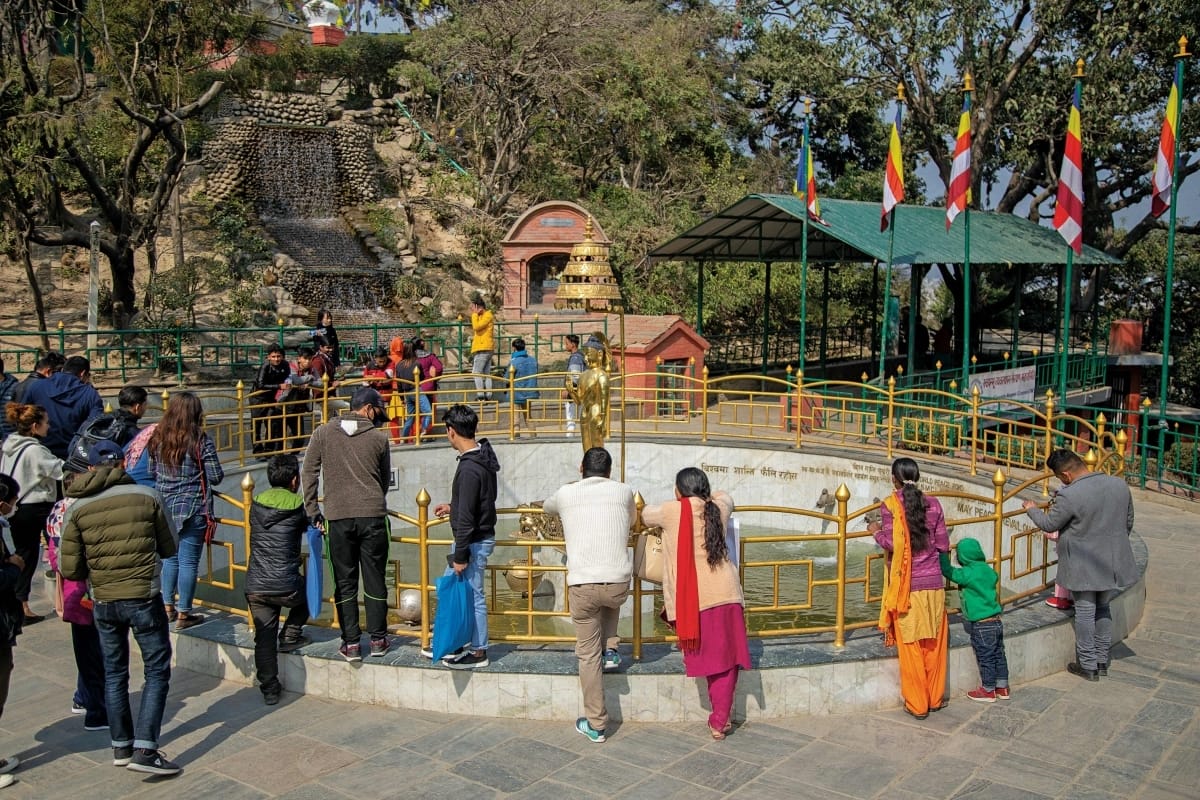Götz Hagmüller has been living in Bhaktapur for twenty-seven long years. His job as manager of the Bhaktapur Development Project brought him to this old city in 1979. He was later to restore the Patan Museum, and his more recent project just completed, is the remarkable Garden of Dreams.
He was sitting in his lovely garden, basking in the mild winter sun when we walked in to announce our arrival. Architect Götz Hagmüller has been living in a historical math in Bhaktapur and has over the years transformed the interior into something quite unique. Although unchanged from the outside, the living space within is a tasteful mix of Asian and western design. When asked how long it took to transform the place, he laughs and says, “ Twenty seven years,” as he leads us through the many marvelous rooms and corridors. That’s how long Götz has been living in this house.
Say the name ‘Hagmüller’ and quite a few people will immediately think of the world-renowned Patan Museum on Patan Durbar Square, or the more recently restored Gardenof Dreams at Kaiser Mahal in Thamel. He also has a book to his name, ‘Patan Museum – The Transformation of a Royal Palace in Nepal’, a 144 page tome which he says, “describes my methods of working in the minutest detail.” Talking about the Garden of Dreams, he tells us an interesting story: “During the time that we were negotiating and preparing the project, one day we were passing by and saw workers breaking down one of the three remaining pavilions of the garden. We met Karna Shakya who immediately took us to meet the Minister in the Kaiser Mahal. Apparently there were plans afoot to break down the external walls of the garden and build a line of shops along the Thamel road. Erich Theophile from the Kathmandu Valley Preservation Trust also happened to see this, and went on to meet Dr. Amatya, who was then the Director General of the Dept. of Archaeology. We lodged our complaint with the D.G. and the destruction was halted immediately. If we had not been on time, the building, and with it the project, would have been gone.”
It may have had something to do with fate, that Götz arrived in Nepal for the first time in 1968, the same year that Kaiser Mahal along with the Garden of Dreams was handed over to the government by the family of Kaiser Shumsher Rana. “I went over to see the garden after reading an article about it by one Dr. Amatya in The Rising Nepal (the same Dr. Amatya who now sits on the Board of the Garden of Dreams). At that time, the garden was still in splendid condition,” he recalls, “and of course, no one could have foreseen my involvement in its future restoration some 35 years late.” Hagmüller was working for the UN then, and stationed in Bangkok. His posting with FAO brought him to Nepal for a short stay, researching the housing situation, essentially, ‘how wood could be used in public housing’. The research took him all over the Far East at the time, but also nurtured a dream: “if my good fortune would ever take me back to Asia again, my preference would be Nepal or Bali”. It turned out to be Nepal. “On my first trip, I was so enchanted by this country, that I wanted to come back,” says Götz. He had visited Bhaktapur, which he remembers as a sleepy farming town that had been bypassed by development, even as the construction of the Arniko highway had affected the towns that fell along its route.
Eleven years later, in 1979 Hagmüller was back in Nepal with the Bhaktapur Development Project (BDP), which was to transform the old town. It was a time when many people were selling off their houses or land in Bhaktapur to move to Kathmandu. Today, they regret having sold their land and want to move back. A dramatic change came over Bhaktapur after the BDP undertook the task of transforming it into a clean city with proper sewage, a drinking and water distribution system and public as well as private toilet systems. The project lasted from 1974 to 1986 and Hagmüller was involved for 4 ½ years. Talking of Bhaktapur, he enthuses, “It was good to see this Malla-time royal city, endowed not only with an abundance of temples and shrines, but with an amazing wealth of public amenities like water supply and common space. Three hundred years ago, all the inner roads of this town were paved with such very good bricks that many could be re-used.”
The project also undertook the task of repairing the old stone waterspouts as well as the many pokharis (massive water storage tanks). “With these ponds, Bhaktapur has the largest artificially created water surface of any city we know,” says Götz, “the urban infrastructure was rich even in comparison with historical cities in Europe”. The project went on to repair patis (the sitting area in the front of old houses where musicians play devotional songs in the mornings and evenings) and maths (the residence of temple priests and caretakers). At the end of BDP, the Pujari Math on Dattatraya Square which had served as BDP’s office was converted into a Woodcarving Museum. Helmut Kohl arrived from Germany to inaugurate the museum.
It was also in 1979 that Götz met Ludmilla Hungerhuber (see ECS August 2006.), who had come to visit a friend. It so happened that they were flying to Germany on the same plane. During their conversation, Götz mentioned the fact that he needed an assistant to which she replied, “Why don’t you hire me.” She got the job and joined the project the following year. Fifteen years later, they walked into the Bhaktapur Nagar Palinka offices and came out as man and wife. “The ladies in the Municipality office were quite amused to see such ‘old’ people still getting married,” he recalls and adds, “Bhaktapur is one of the best administered cities today and there is great emphasis on heritage preservation. It was the first city to collect entry fees for this purpose, and also the first to ban traffic of heavy vehicles.” He believes that the success of the Bhaktapur project was primarily due to the generation of employment for a large number of people as well as due to the formation of Community Development Committees through which locals were motivated towards taking more responsibility for the conservation and development of the city into their own hands. He further adds, “In the end, the project succeeded in re-establishing Bhaktapur somewhat to its former glory, and more people are returning to the old city now. Previously, people used to look down upon Bhaktapur as a city of peasants and communists.” He chuckles. “Well, it is still full of peasants who are, by and large, still communists.”
Born in Vienna in 1939, Hagmüller’s professional education in architecture and urban conservation, as well as in film and television – both during the 1960s in Vienna – had gradually led his career between Austria and many parts of the world until he settled in Bhaktapur 27 years ago.
From urban conservation projects in Salzburg and Vienna, to designing office buildings in Sweden, his interest soon took him to the problems of the developing world, with research assignments for the UN in Africa and the Far East, or with the design of a new National Library in Teheran through an international competition. In between, Hagmüller also produced film, TV and radio documentations in Africa and Latin America, as well as later in India and Nepal.
The last film Götz was involved in together with Niels Gutschow, the eminent German architect, was about their 1987-1990 reconstruction of the precious 18th century Chyasilin Mandap (the “Pavilion of Eight corners”) on Bhaktapur’s Durbar Square, which had been destroyed by the great earthquake of 1934. The mandap was rebuilt from scratch relying on old photographs and etchings for accuracy. (see photo on pg 56)
Next, and along with Shaphalya Amatya, they prepared a Conservation Master Plan for Swayambhunath under the German UDLE project, and consequently were appointed as consultants to the Department of Archaeology for implementing some of this Master Plan. In between, in 1991, 1992 and 1996, Hagmüller undertook advisory assignments in Laos and Angkor Wat in Cambodia.
The team Gutschow-Hagmüller initiated the Patan Conservation and Development Programme’ from 1991 to 1994 again under UDLE/GTZ. One of their success stories he remembers is the stopping of traffic from entering the Durbar Square. “There was a plan to build a two-lane bridge at Sankhamul,” Hagmüller explains, “which would have meant expanding the road that leads up to the square and right through it. If that had happened, there would have been no way to ever ban the traffic across Durbar Square.” As JICA was funding the bridge and the German government was funding our project, we pleaded and there was much communication between Tokyo and Bonn. Our efforts prevailed and eventually the Japanese built a one-lane bridge through which only pedestrians and motorcycles could pass.” Eventually the municipality took it upon themselves to ban all vehicles, including motorcycles from entering the most beautiful square of Nepal.
However, it was during the period 1986 to 1997, as chief architect and project coordinator of the Patan Durbar Conservation and Museum Project, that Hagmüller reached his professional zenith. The restoration of the 17th century Patan Palace and its conversion to adaptive modern use led to the establishment of the famous Patan Museum – a self-sustaining cultural institution and a revenue generating prime tourist attraction of international standards.
In 2001, Götz Hagmüller was awarded the Gorkha Dakshin Bahu by the late King Birendra, and the honorary title “Professor” by the Austrian President. Since then he has been immersed in the restoration of the Garden of Dreams. The restored garden which was inaugurated in October 2006, has been as much a labour of love to Hagmüller as had been the Patan Museum. However, happy as he seems to be with the final result, he regrets smilingly “here, we have restored and converted the two most beautiful historic pleasure pavilions, ready to serve as a garden restaurant and a lounge bar – and thus to create crucial revenues for the garden’s maintenance and operation; but the tendering and selection process for a qualified restaurant operator, long overdue by the powers that be, has not even begun!”
Yet, undeterred by this slowness of things, the architect has embarked in the meantime on a parallel project in Bhutan, “in similarity with the Patan Museum, it aims at restoring a historical building and its adaptive use as a new museum and landmark”. As he says this, one can discern a gleam in his eyes. And why shouldn’t there be? After all, for Professor Götz Hagmüller, it must be like falling in love all over again.
Reinhold Messner
“Traditional mountaineering is the art of not dying.” Reinhold Messner is one of the most well known...









